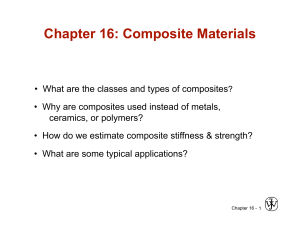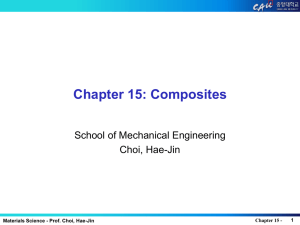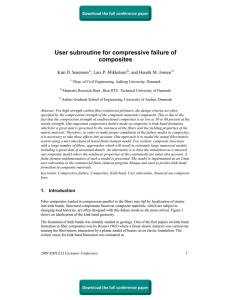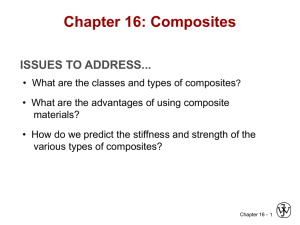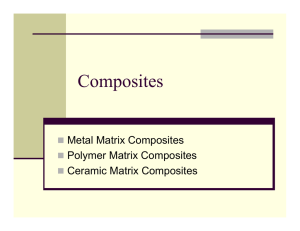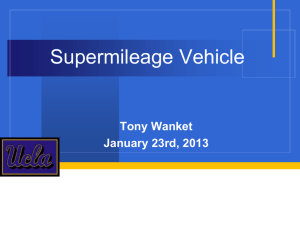16.982 Bio-Inspired Structures MIT OpenCourseWare Spring 2009
advertisement
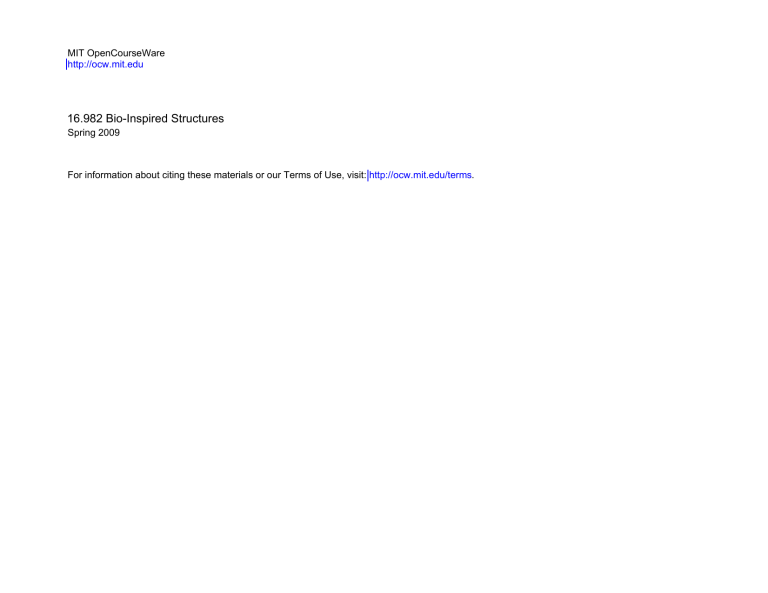
MIT OpenCourseWare http://ocw.mit.edu 16.982 Bio-Inspired Structures Spring 2009 For information about citing these materials or our Terms of Use, visit: http://ocw.mit.edu/terms. ISSUES TO ADDRESS... ADDRESS • What are the classes and types of composites? • Why are composites used instead of metals, ceramics, or polymers? • How do we estimate composite stiffness & strength? • What are some typical applications? • Composites: --Multiphase material w/significant propor pr oportions tions of ea. ea phase. woven fibers • Matrix: --The continuous phase --Pur Purpose pose is to to: transfer stress to other phases protect phases from environment --Classifica --Classif ication: tion: MMC MMC, CMC, PM PMC metal ceramic cross section view polymer • Dispersed Dispersed phase: phase: --Purpose: enhance matrix properties. MMC: increase Vy, TS, creep resist. CMC: increase Kc PMC: increase E, Vy, TS, creep resist. --Classification: Particle, fiber, structural COMPOSITE SURVEY: Particle-I Particle-reinforced Fiber-reinforced • Examp ples: -Spheroidite matrix: ferrite (D) steel (ductile) Image removed due to copyright restrictions. Structural particles: cementite (Fe3C) (brittl ittle)) 60Pm matrix: -WC/Co cemented cobalt (ductile) carbide Vm: 10-15vol%! -Automobile matrix: rubber tires (compliant) Image removed due to copyright restrictions. particles: WC (brittle, hard) 600Pm 600 m Image removed due to copyright restrictions. 0.75Pm particles: C (stiffer) Adapted from Fig. 10.10, Callister 6e. (Fig. 10.10 is copyright United States Steel Corporation, 1971.) Adapted from Fig. 16.4,, Callister 6e. (Fig. 16.4 is courtesy Carboloy Systems, Department, General Electric C Company.) ) Adapted from Fig. 16.5, Callister 6e. (Fig. 16.5 is courtesy y Good year Tire and Rubber Company.) COMPOSITE SURVEY: Particle-II Particle-reinforced Fiber-reinforced Structural • Elastic modulus, modulus Ec, of composites: -- two approaches. upper limit: E(GPa) 350 Data: Cu matrix 300 w/tungsten 250 particles ti l 200 150 “rule of mixtures” Ec VmEm VpEp 0 (C ) (Cu) lower limit: 1 Vm Vp Ec Em E p 20 40 60 80 100 vol% tungsten ((W) W) • Application to other properties: -- Electrical conductivity, y, Ve: Rep place E by y Ve. -- Thermal conductivity, k: Replace E by k. Adapted from Fig. 16.3, Callister 6e. (Fig. 16.3 is from R.H. Krock, ASTM Proc, Vol. 63,, 1963.) COMPOSITE SURVEY: Fiber-I Particle-reinforced Fiber-reinforced • Aligned Continuous fibers • Examples: --Metal: J'(Ni3Al)-D(Mo) by eutectic solidification. matrix: D(Mo) (ductile) Structural --Glass w/SiC fibers formed by glass slurry Eglass = 76GPa; 76GP ESiC = 400GPa. 400GP Image removed due to copyright restrictions. Image removed due to copyright restrictions. 2Pm fibers:J’ (Ni3Al) (brittle) From W. Funk and E. Blank, “Creep -Mo in -situ deformation of Ni3Al Ni3Al-Mo in-situ composites", Metall. Trans. A Vol. 19(4), pp. 987-998, 1988. Used with permission. From F.L. Matthews and R.L. Rawlings, Rawlings Composite Ma Materials; terials; Engineering and Science, Reprint ed., CRC Press, Boca Raton, FL, 2000. (a) Fig. 4.22, p. 145 (photo by J. Davies); (b) Fig. 11.20, p. 349 (micrograph by H.S. Kim, P.S. Rodgers, and R.D. Rawlings). Used with permission of CRC Press, Boca Raton, FL. COMPOSITE SURVEY: Fiber-II Particle-reinforced Fiber-reinforced • Discontinuous, random 2D fibers • Example: Carbon-Carbon --process: fiber/pitch, then burn out at up to 2500C. --uses: disk brakes, gas turbine exhaust flaps, nose cones. Structural C fibers: very stiff very strong C matrix: less stiff less strong 500 µm (b) View onto plane Fibers lie in plane • Other variations: --Discontinuous, random 3D --Discontinuous, 1D (a) Figure by MIT OpenCourseWare. Adapted from F.L. Matthews and R.L. Rawlings, Composite Materials; Engineering and Science, Reprint ed., CRC Press, Boca Raton, FL, 2000. (a) Fig. 4.24(a), p. 151; (b) Fig. 4.24(b) p. 151. COMPOSITE SURVEY: Fiber-III Particle-reinforced Fiber-reinforced Structural • Critical fiber length for effective stiffening & strengthening: fiber strength in tension f d fiber length 15 c fiber diameter shear strength g of fiber-matrix interface • Ex: For fiberglass, fiber length > 15mm needed • Why? Longer fibers carry stress more efficiently! Shorter, thicker fiber: d fiber length 15 f (x) (x) c Longer, thinner fiber: d fiber length 15 f (x) c Adapted from Fig. 16.7, Callister 6e. Poorer fiber efficiency Better fiber efficiency COMPOSITE SURVEY: Fiber-IV Particle-reinforced Fiber-reinforced Structural • Estimate of Ec and TS: d --valid when fiber length 15 f c -- Elastic modulus in fiber direction: Ec Em Vm KE f Vf efficiency y factor: --aligned 1D: K = 1 (anisotropic) --random 2D: K = 3/8 (2D isotropy) --random 3D: K = 1/5 (3D isotropy) Values from Table 16.3, Callister 6e. (Source for Table 16.3 is H. Krenchel, Fibre Reinforcement, Copenhagen: Akademisk Forlag, 1964.) --TS TS in fiber direction: (TS)c (TS)m Vm (TS) f Vf (aligned 1D) COMPOSITE SURVEY: Structural Particle-reinforced Fiber-reinforced Structural • Stacked and bonded fiber fiber-reinforced reinforced sheets -- stacking sequence: e.g., 0/90 -- benefit: balanced, in-plane stiffness • Sandwich panels -- low density, density honeycomb core -- benefit: small weight, large bending stiffness face sheet adhesive layer honeycomb Ad t d ffrom Fi Adapted Fig. 16 16.17, 17 Callister 6e. (Fig. 16.17 is from Engineered Materials Handbook, Vol. 1, Composites, ASM International, Materials Park, OH, 1987. Adapted from Fig. 16.16, Callister 6e. • CMCs: Increased toughness Force 103 E(GP ) E(GPa) PMCs 2 10 10 particle-reinf fiber-reinf ceramics 1 un-reinf Bend displacement 10-4 6061 Al ss (s-1) 6 • MMCs: 10-6 Increased creep resistance i t • PMCs: Increased E/ 10-8 metal/ metal alloys .1 G=3E/8 polymers .01 K=E .1 1 .3 3 1 3 10 30 Density, [Mg/m3] 6061 Al w/SiC whiskers Adapted from T.G. Nieh, "Creep rupture of a silicon-carbide reinforced aluminum composite", Metall. Trans. A Vol. 15(1), pp. 139-146, 1984. Used with permission permission. (MPa) 10-10 20 30 50 100 200 • Composites are classified according to: -- the matrix material (CMC, MMC, PMC) -- the th reinforcement i f t geomettry ((particles, ti l fib fibers, llayers). ) • Composites enhance matrix properties: -- MMC: enhance y, TS, creep performance -- CMC: enhance Kc -- PMC: enhance E, y, TS, creep performance • Particulate-reinforced: -- Elastic modulus can be estimated. -- Properties are isotropic. • Fiber-reinforced: -- Elastic modulus and TS can be estimated along fiber dir. -- Properties can be isotropic or anisotropic. • Structural: -- Based on build-up of sandwiches in layered form.
